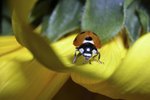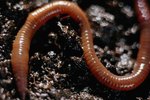Raising millipedes is much easier than raising other types of exotic arthropods since the babies require little special care. However, the life cycle of a millipede from egg to mature adult can take time and patience.
Pet Millipede Environment
Before breeding your pet millipedes, be sure you have the proper environment for your adults. For example, you need an aquarium that is twice as long as your longest adult millipede. You do not need a tall aquarium, but you do need to ensure the habitat is escape proof since millipedes can easily crawl up and out of most open tanks. the bottom of the habitat should be covered in substrate at least as deep as the length of your longest millipede. Your habitat needs to maintain some humidity which you can do by providing a shallow water dish in the aquarium. You also can add a bit of water to the substrate to keep it moist and to increase the humidity in your millipede's aquarium.
Stage 1: Eggs
As long as your adult millipedes are healthy, they will mate. Male millipedes begin the mating process by moving alongside the female's body. When she is ready, he will wrap his body around hers and clasp onto her using specially modified legs on his seventh body segment. Both male and female millipede genitals are located on the third body segment. When mating begins they will rub these segments together in opposite directions. This movement allows the male's sperm to enter the female's body and fertilize her eggs.
A few weeks after mating occurs, the female millipede will dig into the soil of the tank and will lay her eggs. The eggs can be nearly impossible to see because they blend into the soil. However, the female usually will protect the area where she has buried her clutch of eggs so this behavior is a good indicator that baby millipedes are on the way. Millipede females can lay up to 100 eggs at a time so you may need to increase the amount of soil to make sure the babies will have enough room to molt. However, the process is slow so you will have time. On average, millipede eggs take three months to hatch.
Stage 2: Nymphs
When the eggs hatch, the nymphs that emerge will not look much like millipedes. These babies only have a few body segments and usually no more than four pairs of legs. In comparison, adult millipedes have anywhere from 30 to 350 pairs of legs depending on the species. At this point, the nymphs do not require any special care compared to the adults. However, the nymphs are more fragile than the adults so avoid moving them until they are mature.
During this stage in their life cycle, the millipedes will go through numerous molts. A molt occurs when an arthropod loses its old exoskeleton and replaces it with a new, larger one. The millipede will dig itself into a chamber in the soil when it is ready to molt and will emerge with more body segments each time. On average, millipedes will reach their full size in two to five years. The speed of growth and the number of segments added with each molt varies from species to species.
Stage 3: Adults
Adult millipedes need a healthy environment if they are going to thrive. First, they need an appropriately sized aquarium or terrarium tank. You can usually keep up to four large, adult millipedes in a 10-gallon tank. However, the needs of your pet will depend on the species you are keeping. You also need to cover the tank's bottom with 4 inches of soil so the millipedes have plenty of room to move around and to lay more eggs. You can add branches, wood, moss and other items to the tank to create a more pleasant environment for the millipedes. They will use the moss and wood for food. If you add damp wood to the tank, it will help keep the humidity levels in the tank good for your millipedes. You do not want them to dry out.
Although your pets can live off the wood and vegetation in the tank, you can also add other types of fruits and vegetables, such as potato, cucumber, apples, bananas or melons. You can experiment with small amounts of these items to see which ones your millipedes prefer. Keep in mind that your millipedes main source of food is the substrate so maintain the appropriate levels of that in your tank at all times. You also need to supply them with calcium, which comes in the form of a commercially prepared powder and fresh water in a shallow dish.
Adult millipedes kept as pets can begin mating immediately so if you do not want more babies you will want to separate the males and females early. You can do this by looking for the modified leg on the seventh segment of the male millipede body. On average, millipedes can live in captivity for up to 10 years.
Writer Bio
Amy Jorgensen has ghostwritten more than 100 articles and books on raising and training animals. She is also an amateur dog trainer. She has also written more than 200 blog posts, articles, and ebooks on wedding and party planning on behalf of professionals in the field.





